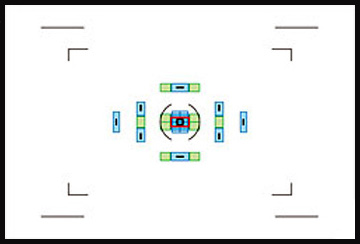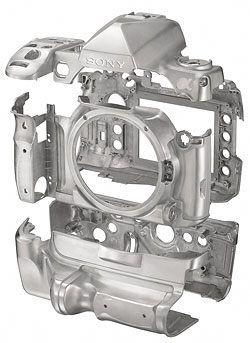Sony A900 Full-Frame: Hands-On Preview
by Wesley Fink on September 12, 2008 12:00 AM EST- Posted in
- Digital Camera
A900 Praise
When a camera and company truly break new ground, as the A900 does, there is plenty to like. The A900 also exhibits quite a few market firsts:

The blue bars are the 9 AF sensors and the green bars are the 10 hidden AF assist points.
The outer lines are used to compose 16:9 HD format, and the etched corners are APS-C mode.
The outer lines are used to compose 16:9 HD format, and the etched corners are APS-C mode.
- The Most Amazing Viewfinder - If the reason for an SLR is the through-the-lens view, and it certainly is in the opinion of most, then the A900 wins in spades with the brightest, sharpest viewfinder seen in any SLR in a long time - perhaps ever. Sony and the Minolta engineering staff they bought have lavished attention on the prism and 100% view and it clearly shows. The only complaint is that eye-relief, while excellent, could be even better. It will be difficult for some eyeglass wearers to see the whole viewfinder and displays without moving their eye a bit. The view is so beautiful and clear you will definitely want to see it all.
- A 24.6MP CMOS Sensor - Some will complain that noise is not as low as the Nikon D3 at high ISOs, and the answer is so what? The A900 is the highest resolution full-frame you can buy and twice the resolution of the D3. If you think that doesn't matter ask a working professional who is trying to supply images to his ad agency. Image buyers are demanding larger and larger files from photographers and the Sony delivers.
- Body-Integrated Image Stabilization - Calling it SteadyShot Inside instead of Super SteadyShot is just a marketing decision. The technology is still "Super SteadyShot" and Sony had to beef up the drive motors by 50% just to keep up with the added motion of a full-frame. Industry observers marveled when Minolta made the APS-C sensor Image Stabilized, because it was so much harder than stabilizing the tiny P&S sensors. We should all stand in awe that Sony accomplished body IS in a full-frame sensor.
- Image Stabilization with Any Lens - With body IS any lens you can mount can be an IS lens. This is particularly welcomed in very large aperture lenses, which are often prohibitively expensive for optical IS since such huge elements have to be compensated. Sony has taken advantage of this with a growing collection of fast, but very expensive, Zeiss lenses.

- Rugged Magnesium Alloy Body with Complete Weather Sealing - Sony passed around the alloy shell of the A900 at the A900 introduction. It is amazing how light the structure actually is considering the incredible strength of the assembled shell. We also saw full seals and gaskets for all buttons and openings and the rubber gaskets for ports seal effectively but are still easy to remove and reseal.
- Very Decent High ISO Noise - Compared to its real competition, which is the Canon 1Ds Mark III, the Sony sensor is amazingly low noise. According to pro photographers we talked with who have been shooting the A900 for several weeks the A900 is cleaner at ISO 800 and 1600 than the Mark III and just as clean at ISO 400. If this proves to be true in test comparisons this should certainly be considered a Sony success. The Canon 5D replacement may write a new chapter in this comparison, but only if it destroys the 1Ds Mark III performance. The A900 is not a D3 or D700 as it only goes to ISO 6400 and shooting at 3200 and 6400 is a when needed option - not something you want to do routinely. However, the A900 is also twice the resolution of the D3 and D700.
- 126 MB per Second - the Dual BIONZ processors in the A900 move 126MB/sec at the 5 fps shooting speed - faster even than the Canon 1Ds III. That's pretty good performance for a camera that will sell for $3k instead of the $8K for the Canon.

- Flash that Makes L Brackets Obsolete - Fortunes have been made with L brackets for pro cameras that enable shooting flash vertical with the flash also rotated 90 degrees. When you see the new Sony HVL-F58AM flash, you'll wonder why Sony - or you, or anyone else - didn't think of it sooner. The flash head turns smoothly in a 90 degree arc as one of its movements - aligning the flash perfectly for portrait mode. Goodbye L bracket.
- Sony PhotoHD output to Bravia TV - The support for direct tethered output via HDMI to Sony's Photo HD on a Sony Bravia TV is no passing feature. The performance and results seen at the Toronto hands-on were stunning. Output from the A900 model shoot and the studio shoot with fishing lures and flies was direct to huge Sony HD Bravia displays.
- Complete Familiarity - Users of the Sony A700 will have no learning curve at all, which is always a good thing. The layout of the A700 and A900 and grips are exactly the same, making for instant familiarity.
- True RAW Files - The Sony A700 has been criticized by some sites for not providing true RAW images, as even the Sony RAW had some noise-reduction applied with questionable success. The A900 finally has the RAW option of "No Noise Reduction". Sony will also provide this option to A700 owners in the upcoming firmware version 4.










53 Comments
View All Comments
sprockkets - Saturday, September 13, 2008 - link
Flash that Makes L Brackets Obsolete - Fortunes have been made with L brackets for pro cameras that enable shooting flash vertical with the flash also rotated 90 degrees. When you see the new Sony HVL-F58AM flash, you'll wonder why Sony - or you, or anyone else - didn't think of it sooner. The flash head turns smoothly in a 90 degree arc as one of its movements - aligning the flash perfectly for portrait mode. Goodbye L bracket.Sorry, quote funtion wouldn't work. Why is this an issue? Flashes for the longest time do something really easy to bounce or flash vertically in portrait mode. It's called they rotate horizontally. The only advantage here I suppose is that the back display is now easier to read facing up. Am I missing something here?
Maxington - Monday, September 15, 2008 - link
I was wondering the same thing about the Sony flash, exactly what is so special about it?I can do ceiling bounce flash holding the camera in portrait with my Pentax 540 flash, and that's been out for years.
What is this Sony flash doing that has everyone so excited?
randomlinh - Sunday, September 14, 2008 - link
I was thinking the same... this moves the flash a little closer in line with the lens.. but l brackets still have one huge advantage... it RAISES the flash up, which can be quite beneficial in itself.Crafty Spiker - Saturday, September 13, 2008 - link
Regardless of the product - do you really want to "vote" for Sony?melgross - Friday, September 12, 2008 - link
It's interesting that both Canon's 5D, and Nikon's D700 cameras are considered to be, even by their manufacturers, advanced amateur or semi-pro bodies, but at the same price level, the Sony 900 is considered to be professional, ala the Canon 1Ds, 1D, and Nikon D3.Sorry, this camera isn't built like those pro bodies from Canon and Nikon.
While pro's certainly use the 5D, and D700, they also use the 40D and the D300.
So, are those now pro bodies as well?
Sensor size doesn't determine whether a body is pro, and really, neither does weather sealing.
The 1Ds 1D, and D3 are certainly the most rugged bodies on the market, nothing else approaches them in this.
chiew - Sunday, September 14, 2008 - link
Sony has no weather sealed lenses...I doubt pros who shoot in adverse conditions will want a Sony until it is proven.Wesley Fink - Saturday, September 13, 2008 - link
The Canon 5D and Nikon D700 have 95% wiewfinders. So do the D300 and 40D. The Nikon D3, Canon 1Ds MkIII, AND Sony A900 all have 100% viewfinders. That is certainly one measure of a Pro camera.In comparing the build quality of the A900 to my D3 I did not find the A900 lacking. Of course the test of time is what matters most in evaluating build quality and it will take a while to see if the build is as rugged as it appears.
I assumed the grip would be an Achilles heel since the other Pro models have a built-in grip. However, the A900 grip uses the same magnesium alloy shell and sealing used on the a900. Still, an integrated grip would certainly be better sealed almost by definition. Frankly I prefer a grip I can leave at home if I choose. The true Pro models that fit your criteria are all a pain to lug around in the field. That's why my D4 stays at home sometimes and the D700 goes with me.
In the end I have no doubt the Sony is as well constructed as the other cameras you judge as Pro. I do, however, have reservations about a shutter that is only rated for 100,000 actuations. That is very low for a camera to be considered Pro, and is much more typical of semi-Pro or Advanced prosumer models.
melgross - Wednesday, September 17, 2008 - link
Big deal. Over the years, the Nikon F series had a 100% viewfinder. That didn't prevent Canon from knocking it off it;s top spot, even though Canon didn't consider that to be important.In fact, for many years, a 100% viewfinder was considered to be a negative. When we shot transparencies, the mount covered the millimeter around the outside edge of the slide, making what you saw no more than about 96% of the total. Using a 100% viewfinder often caused the mount to hide the edge of what you saw anyway.
Nowadays, it;s true, that doesn't matter, but 2 to 5% of the viewfinders outside edges is of no real noticeable importance if its less than the full frame. The problem would be the other way around.
I think the shutter is far more important in telling us what this camera is intended for than whatever else we can see from the outside. Can't judge a camera by its shell. Even the 5D II now has a 150,000 cycle shutter.
Lord 666 - Saturday, September 13, 2008 - link
The D300 has a 100% viewfinder. However, at $3000 for the D700, they could have easily used the same from D3... but more than likely did not to protect sales of D3.http://www.nikonusa.com/Find-Your-Nikon/Product/Di...">http://www.nikonusa.com/Find-Your-Nikon/Product/Di...
Wesley Fink - Saturday, September 13, 2008 - link
You are correct, the D300 does have a 100% finder. Mea Culpa.